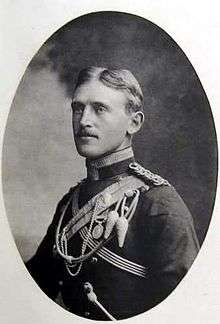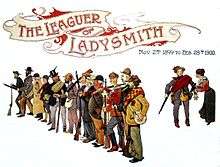Clive MacDonnell Dixon
| Clive MacDonnell Dixon | |
|---|---|
 | |
| Born |
10 February 1870 Middlesbrough, England |
| Died |
11 May 1914 (aged 44) Ypres |
| Nationality | United Kingdom |
| Institutions | 16th Lancers< |
| Known for | His book "The Leaguer of Ladysmith" |
Major Clive MacDonnell Dixon (10 February 1870 in Middlesbrough – 5 November 1914 in Ypres) was an English illustrator and soldier, best known for the charming images in his book The Leaguer of Ladysmith, created during the four-month Siege of Ladysmith in South Africa. This material also appeared in the Ladysmith Lyre at the time of the siege. The Sphere praised the book, describing it as 'highly humorous and showing comic sketching genius'.

Dixon was the fifth-born in a family of 6 daughters and 2 sons of Sir Raylton Dixon (1838–1901), shipbuilder from Cleveland Dockyard, Middlesbrough-on-Tees, mayor of Middlesbrough in 1889, himself an amateur artist and caricaturist, and great, great grandson of George Dixon and great great nephew of Jeremiah Dixon.[1][2]
He attended Rugby School and Sandhurst before embarking on a military career and was appointed second lieutenant in the 16th Lancers in October 1890, and Captain in 1899. During the Second Anglo-Boer War 1899-1901 he was aide-de-camp to Sir George White, and was promoted a brevet Major in November 1900.[3]
Dixon married Lilian Margaret Bell daughter of John Bell of Rushpool Hall, with whom he had three sons, Raylton, John and William and three daughters Margaret, Elizabeth and Barbara.[4] He was killed at Ypres shortly after receiving the substantive promotion to Major. He was buried in the Nieuwkerke Churchyard in Belgium.
Several watercolours by Dixon are kept by the Africana Museum.
References
| Wikimedia Commons has media related to Clive MacDonnell Dixon. |
- ↑ Artists and Illustrators of the Anglo-Boer War - Ryno Greenwall
- ↑ http://www.pennyghael.org.uk/Dixon.pdf
- ↑ The London Gazette: no. 27359. p. 6305. 27 September 1901.
- ↑ http://1914-1918.invisionzone.com/forums/index.php?s=759a2650e3c0670cfaa93b804326788e&showtopic=63171&pid=553103&st=0&#entry553103